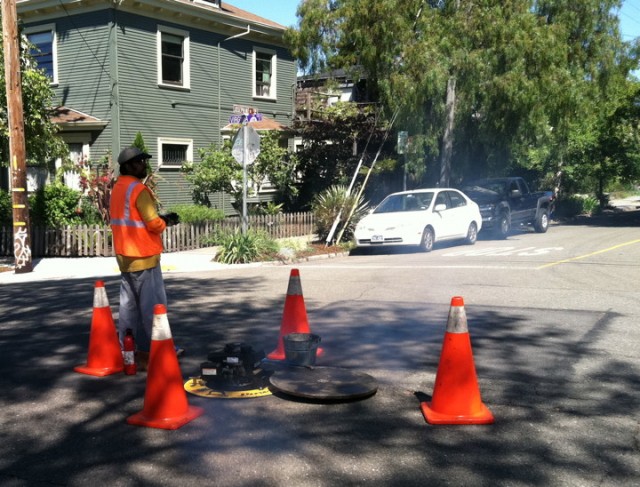For Berkeley, that means paying a civil penalty of $133,500, cleaning 51 miles of sewer mains per year, inspecting 15 miles per year and rehabbing 4 miles per year.
According to city spokesman Matthai Chakko, over 80 percent of the rehabbing of sewer mains and associated lower laterals in Berkeley has already been completed. He also said that the city cleaned 64.1 miles of sewer lines in 2013, and that Berkeley was achieving the annual 15 miles per year inspection goal. Last year, the city inspected 17.4 miles, he said.
The East Bay’s entire sewer infrastructure is 1,500 miles long and the estimated total cost of repair is $1.5 billion.
Homeowners are responsible for nearly half of that cost.
When private property owners sell or renovate their properties, they are required to inspect and upgrade the sewer laterals that connect the property to the city’s sewer mains. The settlement’s wide timeframe of 21 years was chosen in part because many homes will be sold by 2035, said EPA spokeswoman Suzanne Skadowski.
“Personally, each homeowner is on the hook,” said EBMUD spokeswoman Andrea Pook. “The city’s part is to upgrade its sewer lines. Then it’s EBMUD’s role to oversee the private sewer lateral program, and work on the miles of large pipeline that we own and improve those.”
Berkeley is unusual in that predating the settlement, the city already had its own ordinance requiring private property owners to upgrade their sewer laterals, said City Attorney Zach Cowan, who negotiated the agreement.
“After further discussions and hearing other people’s experiences with their ordinances, we thought it could use some tweaks and refinements,” Cowan said. “There were some changes we made just because the EPA wanted language in there, and some changes we made to accommodate people buying houses.”
The City Council will vote on the first reading of an amendment to the Private Sewer Lateral Ordinance on Sept. 9.
As for the cost of cleaning and repairing the city-owned infrastructure, “that’s what sewage rates are for,” Cowan said. The city of Berkeley is conducting a sewer rate study that is likely to result in increased rates, he said.
The flaws in the East Bay’s sewage system, which was built in the late 1950s, are common throughout the country.
“Aging infrastructure is a big problem everywhere,” said Skadowski. “The EPA has done similar agreements with other utilities over the last decade or so. It takes time and momentum to get the utilities and communities to put money toward making those repairs.”
Between 1990 and 1996, EBMUD built three wet-weather facilities to alleviate the pressure on the main sewage treatment plants when wastewater reached capacity during storms. Initially the facilities succeeded in reducing wastewater discharge, but they can’t handle current levels of overflow.
The environmental impact of untreated sewage water in the bay is significant, Skadowski said.
“When you do a big discharge into a water body like that, there’s a good chance that it’s going to result in depleted oxygen, and that’s bad for the marine life,” she said. The discharge may contain other pollutants like toxic metals or pathogens, she said.
The settlement negotiations took over a year, but all parties involved believe the final terms are feasible, Cowan said.
“It was difficult stuff but we all ended up in agreement,” he said.
